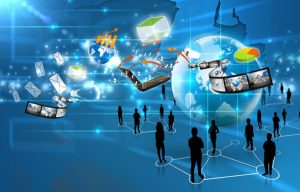Tech Trends and Innovations: A Deep Dive into Connectivity, Computing and Healthcare

In the ever-evolving landscape of technology, staying informed about the latest advancements is crucial. “Tech Trends and Innovations” provides an insightful exploration of cutting-edge developments in connectivity and communication, advanced computing and processing, immersive experiences and simulation, transportation and mobility, cutting-edge science and exploration, and healthcare and medicine. Discover how 5G technology is reshaping communication, how quantum computing is tackling complex challenges, and how augmented reality and virtual reality are transforming remote interactions.
Dive into the world of autonomous vehicles and space exploration technologies, which promise to reshape our transportation systems and expand our knowledge of the cosmos. Furthermore, explores how biotechnology and advanced tech are revolutionizing genomics and drug discovery, and how quantum computing is accelerating drug development. This comprehensive resource offers a glimpse into the future of technology and its profound impact on various industries and facets of our lives.
Connectivity and Communication Technologies:
5G Technology
- 5G Technology represents the fifth generation of wireless communication technology. It offers vastly improved data transfer speeds, lower latency, and the ability to support a massive number of devices simultaneously. 5G is poised to revolutionize connectivity, enabling innovations in areas like IoT (Internet of Things), smart cities, autonomous vehicles, and high-definition video streaming.
Quantum Computing
- Quantum Computing (for network optimization) refers to the utilization of quantum computing capabilities to enhance network performance and efficiency. Quantum computers can solve complex optimization problems quickly, which is valuable in tasks like routing and resource allocation in communication networks, ultimately leading to more robust and responsive networks.
Augmented Reality (AR) and Virtual Reality (VR)
- Augmented Reality (AR) and Virtual Reality (VR) are technologies that immerse users in digital experiences. In the context of enhanced remote communication, AR and VR can simulate in-person interactions over long distances. For example, AR can overlay digital information onto real-world environments during remote meetings, while VR can create fully immersive virtual meetings and collaborative spaces, making remote communication more engaging and effective.
Advanced Computing and Processing:
Quantum Computing
- Quantum Computing (for solving complex problems) involves using quantum computers to address computationally challenging tasks that are beyond the capabilities of classical computers. Quantum computing’s power lies in its ability to process and analyze complex data sets, solve optimization problems, and simulate quantum systems with unparalleled speed, impacting fields such as cryptography, materials science, and logistics.
Biotechnology and Tech
- Biotechnology and technology trends(for advanced data analysis in genomics and drug discovery) describes the integration of technology into biotechnology for analyzing complex biological data. High-performance computing and data analytics play a crucial role in genomics research and drug discovery by enabling the processing and interpretation of vast genomic datasets. This can lead to the identification of disease markers and the development of more targeted therapeutics.

Immersive Experiences and Simulation:
Augmented Reality (AR) and Virtual Reality (VR)
- Augmented Reality (AR) and Virtual Reality (VR) are technologies that create immersive digital experiences. AR enhances the real world with digital overlays, while VR immerses users in entirely virtual environments. Both are used for gaming, education, training simulations, and in industries such as architecture and healthcare to create realistic and interactive experiences.
Autonomous Vehicles
- Autonomous Vehicles (for training and simulation) involve the use of simulators to train self-driving vehicles. Simulated environments enable safe and controlled testing of autonomous vehicle algorithms, helping developers refine their technology and algorithms to ensure the safety and reliability of autonomous transportation systems.
Space Exploration Technologies
- Space Exploration Technologies (for astronaut training and remote exploration) encompasses the application of advanced technologies to train astronauts for space missions and to explore remote regions of space. This includes using virtual environments and robotics for astronaut training and remote-controlled spacecraft for exploring celestial bodies like the Moon and Mars.
Transportation and Mobility:
Autonomous Vehicles
- Autonomous Vehicles are self-driving cars and other forms of transportation that can operate without human intervention. These vehicles use a combination of sensors, artificial intelligence, and advanced control systems to navigate roads safely. They have the potential to transform transportation by improving safety, reducing traffic congestion, and enabling new mobility services.
Space Exploration Technologies
- Space Exploration Technologies (for reusable spacecraft and lunar/Martian rovers) involve the development of reusable spacecraft for cost-effective space exploration and the creation of rovers for lunar and Martian missions. This technology is vital for reducing the cost of space exploration and advancing our understanding of the cosmos, potentially paving the way for human missions to other planets.
Cutting-Edge Science and Exploration:
Space Exploration Technologies
- Space Exploration Technologies refer to innovations and advancements in spacecraft, launch systems, and mission designs for exploring space. This includes the development of reusable rockets, advanced spacecraft, and instruments for studying and reaching distant celestial bodies, with the ultimate goal of expanding human exploration to Mars and beyond.
Biotechnology and Tech
- Biotechnology and Tech trends(for space-based research and experiments) denotes the application of biotechnology and advanced technology for conducting scientific experiments and research in space. This research helps us understand how space conditions affect living organisms and allows for the development of technologies that support long-duration space missions and potential human colonization of other planets.

Healthcare and Medicine:
Biotechnology and Tech
- Biotechnology and Tech trends(for medical advancements and personalized medicine) involve the use of biotechnology and advanced technology to advance healthcare. This includes genetic therapies, precision medicine, and data analytics to improve patient outcomes, making healthcare more tailored and effective.
Quantum Computing
- Quantum Computing (for drug discovery and molecular modeling) explores how quantum computing can accelerate drug discovery and molecular modeling processes. Quantum computers can simulate complex molecular interactions and identify potential drug candidates more efficiently, which is vital for advancing pharmaceutical research and development.
Conclusion:
The world of technology is in a perpetual state of innovation and transformation. Emerging technology trends such as artificial intelligence, 5G connectivity, quantum computing, and sustainable technologies are poised to reshape industries, economies, and our daily lives. While predicting the precise future of technology remains a complex task, one thing is certain: our ability to adapt, embrace, and harness these advancements will play a pivotal role in shaping the world of tomorrow.
As we navigate the ever-evolving landscape of technology, it is essential to remain vigilant about ethical considerations, data privacy, and the equitable distribution of benefits. By staying informed, fostering collaboration, and nurturing a culture of responsible innovation, we can collectively steer technology toward a future that brings positive advancements and enriches the human experience.
Frequently Asked Questions:
What is new trends in technology?
Technology trends are continually evolving, but some prominent recent developments include the widespread adoption of 5G networks, advancements in quantum computing, the growing importance of cybersecurity, and the increasing use of artificial intelligence and machine learning in various industries. Additionally, the Internet of Things (IoT), augmented reality (AR), virtual reality (VR), and sustainable technologies are gaining momentum.
What are the big tech trends?
Big tech trends include artificial intelligence (AI) and machine learning, 5G technology, quantum computing, cybersecurity measures, autonomous vehicles, and the Internet of Things (IoT). These technology trends are driving innovation across industries and have the potential to reshape the way we live and work.
What are the tech trends in 2025?
While it’s challenging to predict specific tech trends in 2025, some areas of focus are expected to be advanced AI and machine learning applications, further development of quantum computing, the proliferation of IoT devices, increased sustainability and renewable energy technologies, and continued advancements in healthcare technology.
What are the tech trends for 2024?
Predicting exact tech trends for 2024 is speculative, but we can anticipate ongoing developments in AI, 5G network expansion, cybersecurity enhancements, and an increasing emphasis on eco-friendly technologies as potential highlights.
What is the top technology for 2023?
The top technology for 2023 may vary depending on the industry and perspective. However, AI and machine learning, 5G, and quantum computing are likely to remain at the forefront of technological advancements.
What is 2023 technology of the year?
The “technology of the year” can vary by organization and industry, but in 2023, it’s possible that AI-driven solutions, quantum computing advancements, or innovations in renewable energy and sustainability could be recognized as noteworthy technologies.
What’s the next big technology?
The next big technology could be in various areas, including advanced AI applications, developments in biotechnology and genomics, sustainable energy solutions, or transformative advancements in cybersecurity.
What is the future technology in 2050?
Predicting technology in 2050 is highly speculative, but it may include advanced AI that can replicate human-like intelligence, renewable energy sources powering the world, significant advancements in space exploration and colonization, and healthcare innovations extending human lifespans.
Which is the best technology to learn for the future?
The best technology to learn for the future depends on your interests and career goals. Currently, AI, machine learning, data science, cybersecurity, and software development are high-demand fields with promising futures.
Which technology is in demand?
Technologies in high demand include AI, cybersecurity, data analytics, cloud computing, and blockchain. These fields offer numerous career opportunities and are essential for many industries.
What is the fastest-growing technology?
Artificial intelligence and machine learning are among the fastest-growing technologies. They are being applied in various domains, from healthcare and finance to autonomous vehicles and customer service.
What is the next big thing after AI?
Predicting the next big thing after AI is challenging, but some possibilities include advanced biotechnology, quantum computing, and developments in clean energy and sustainable technologies.
What is the most advanced AI possible?
The most advanced AI possible is often referred to as artificial general intelligence (AGI). AGI would have human-like cognitive abilities, including the capacity for reasoning, problem-solving, and understanding context across a wide range of tasks.
What industry will be replaced by AI?
AI has the potential to impact numerous industries, including manufacturing, customer service, healthcare, finance, and transportation. However, rather than replacement, AI is often seen as a tool that enhances productivity and efficiency within these sectors.
Which sectors will be replaced by AI?
Sectors that heavily rely on repetitive, rule-based tasks are more likely to see automation and AI integration. This includes manufacturing, data entry, and some customer service roles.
Which jobs are most at risk from AI?
Jobs at the highest risk from AI are typically those involving routine, repetitive tasks. This includes roles in data entry, manufacturing, telemarketing, and some aspects of customer service.
What is the new technology in AI for 2023?
In 2023, AI is expected to advance in natural language processing (NLP), reinforcement learning, AI ethics and fairness, and AI-powered automation across various industries.
Which industry will not be affected by AI?
It’s challenging to identify an industry that won’t be influenced by AI to some extent. However, sectors with minimal technological interaction, such as certain artisanal crafts, may see less direct impact.
What are the three limitations of AI today?
Three limitations of AI today include:
-
- Lack of common-sense reasoning: AI struggles with understanding context and common-sense knowledge.
- Data bias: AI can inherit biases from training data, leading to unfair or biased decisions.
- High energy consumption: Some AI models require vast computational resources and energy.
What is the negative future of AI?
A negative future of AI could involve widespread job displacement, privacy concerns, misuse for malicious purposes, and ethical dilemmas related to AI decision-making.







